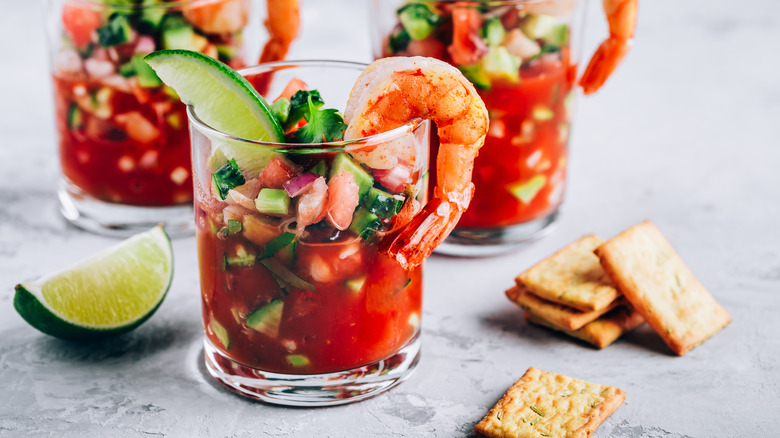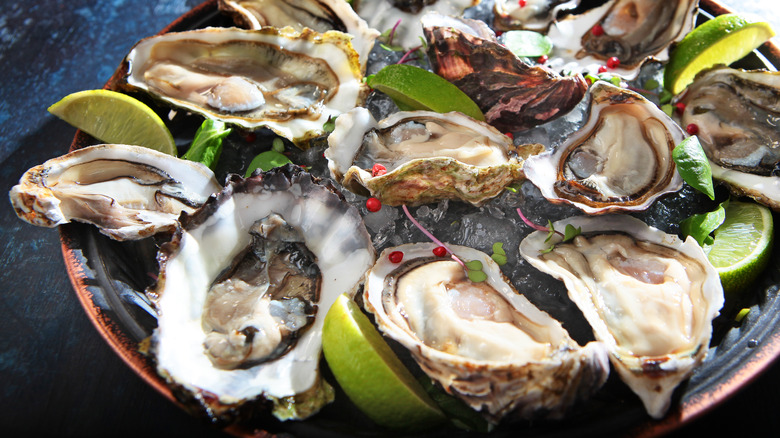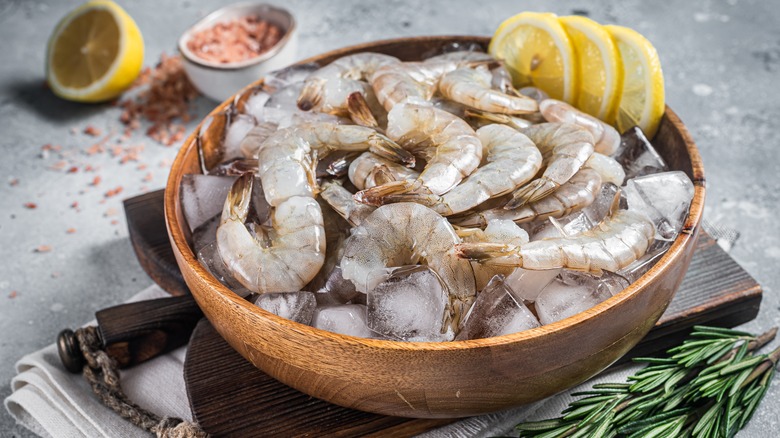Cocktail Sauce Was First Paired With Oysters, Not Shrimp
There are few food pairings more iconic than cocktail sauce and shrimp, but like so many famous foods, their marriage wasn't preordained, and it only came about after some major changes in the way we eat seafood. The match makes perfect sense now (as these things always do in retrospect), with tangy, acidic cocktail sauce bringing bite and brightness to the shrimp's mild, salty sweetness. In fact, that flavor pairing is exactly why cocktail sauce was invented, though it was intended for an entirely different seafood: the oyster.
Like most recipes, the specific origins of cocktail sauce are disputed and a bit unclear. Seafood cocktails of all different varieties were popular back in the 1920s, as Prohibition pushed restaurants to find uses for their still abundant cocktail glasses. The sauce itself dates back even further. It started appearing as an accompaniment for seafood in recipes more frequently in the late 19th century, and may have evolved from a common food of the California gold rush, when prospectors and workers in San Francisco reportedly started eating oysters topped with ketchup.
When the other key ingredients like horseradish and Worcestershire sauce got involved isn't clear, but sometime in the next few decades, the formula evolved to something resembling its current form, except that the food of choice to pair it with remained oysters. It wasn't a change in tastes or an enterprising chef that pushed the switch to shrimp, but the combination of environmental change and technological evolution.
Oysters used to be a cheap street food
Oysters were a mainstay of the American diet for hundreds of years. When Europeans first came to North America they discovered oyster beds in places like Chesapeake Bay and New York Harbor. So, New York City was known for its oysters, with some experts estimating that half of the world's supply once grew in the waters surrounding the then-fledgling city. This abundance made oysters extremely cheap, and as early as the 18th century, workers and sailors were consuming massive quantities of oysters from street carts and oyster bars. The oyster craze even expanded inland, as canning technology made it possible to ship them across the country. Cookbook and restaurant menus of the era, even in the oysterless Midwest, are filled with different recipes and preparations.
Yet oysters' abundance and popularity led to their downfall as a cheap, common food. In San Francisco, where oysters existed but were not as plentiful as on the East Coast, other miners and port workers were credited with pairing oysters and ketchup ate through the entire supply of oysters in a matter of decades. The demand for eastern oysters led to overharvesting, which destroyed the ecosystem that produced them. Industrial runoff also poisoned the water that oysters grew in, making them unsafe to eat. In the early 20th century, the oyster industry collapsed, and prices skyrocketed.
Technology helped make shrimp cheap and widespread
While the innovations that helped make oyster harvesting easier also nearly destroyed the industry, more modern technologies are also what made shrimp widely available. Shrimp are normally extremely perishable, which meant their market was limited to coastal regions where people could buy recently caught fresh shrimp. But the rise of modern commercial refrigeration in the late 19th century, along with railroads, allowed shrimp to be preserved and shipped inland, making them cheaper and more accessible. The shrimp industry was growing at the same time the oyster industry was collapsing, and it was around this time in the early 20th century that the first shrimp cocktails started to replace oysters on menus. After WWII further shipping innovations expanded the availability of shrimp, and shrimp cocktails took off as a staple appetizer and party dish across the country.
Even with that clear timeline, the evolution from oyster cocktail to shrimp has some hazy periods. For one, oyster cocktails were closer to an actual cocktail, with the sauce being a Bloody Mary-like concoction with an oyster in it that was slurped down as a drink. Nor did everyone accept the shrimp cocktail either, as James Beard called it an "overpowering red menace" that ruined shrimp's delicate flavor. But no matter its origins, the masses clearly disagreed, and shrimp cocktail has stuck around as a perennial favorite. Just remember that if you love it, you have oysters to thank.


